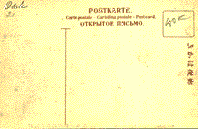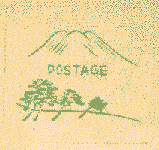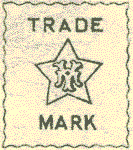 Below are listed the standard features of the postcard's address side (i.e., obverse). These are referred to in the album page card descriptions. Keywords used there are shown below in red. "Non-standard" features will be described as the need arises. For instance, luxuriant floral borders in an Art Nouveau manner sometimes threaten to overwhelm the utilitarian layout of the ordinary postcard. Or there may merely be an "extra" such as horizontal address lines for the writer's convenience.
Below are listed the standard features of the postcard's address side (i.e., obverse). These are referred to in the album page card descriptions. Keywords used there are shown below in red. "Non-standard" features will be described as the need arises. For instance, luxuriant floral borders in an Art Nouveau manner sometimes threaten to overwhelm the utilitarian layout of the ordinary postcard. Or there may merely be an "extra" such as horizontal address lines for the writer's convenience.
Type of foreign-language inscription
Four general design categories occur in the present group of cards. All four (and probably others) were in concurrent use; but,
perhaps, an examination of a large number of cards might yield some relative chronology. There are variations
of each type--height of inscription, type face, color, decorative flourishes. All the postcards carry the Japanese term  yuubin hakaki "postcard" and so fall within to the period 1905-1933. This inscription usually is located along the right-hand edge of the card; only exceptions are explicitly mentioned in the card descriptions. yuubin hakaki "postcard" and so fall within to the period 1905-1933. This inscription usually is located along the right-hand edge of the card; only exceptions are explicitly mentioned in the card descriptions.
TYPE 1
- "Post Card" The earliest example I own of this type is from the 1905-07 period. It is also inscribed, in the manner of United States postcards, "The Address only to be Written on this Side." Below that, instead of on the right side, the Japanese inscription is:  bankoku-yuubin-rengou-hakaki "Universal Postal Union Postcard." This form is familiar from the government-printed cards. bankoku-yuubin-rengou-hakaki "Universal Postal Union Postcard." This form is familiar from the government-printed cards.
TYPE 2
- "Union Postale Universelle / Carte Postale" This type also goes back to the 1905-07 period and reproduces the terminology of the government-printed cards. Perhaps it was gradually replaced by the simpler TYPE 3 during the Taisho years (1912-1926). The first line of print is smaller than the second line, but the proportional difference between the two varies.
TYPE 3
- "Carte Postale" Like TYPE 1, this one enjoyed long and abundant use. In some cards of the 1907-18 period, hakaki appears under the French term, rather than on the right-hand side. Is this a legacy of the type 2 (or the early type 1) format?
TYPE 4
- Multilingual inscription Did this type flourish mainly from 1910 to the early 1920s? In the United States, a German/French/English format dates to the earliest private cards. (See the Harvey Beagle site in References on the Introduction page.) In Japan, a five-language version seems to be the most common form. The example shown above, in German//French/Italian/English//Russian (1907-18 and beyond) has the German POSTKARTE on line 1 in large capitals, the Russian term in smaller capitals on line 3. A variation has the French term on top. A 15-language version puts French/English/German on top.
Vertical divider
The divider
usually is a plain, straight line but can be ornamented in various ways--e.g., scrolls or other decorative elements at the ends. An inscription (most often "Made in Japan") may be placed alongside it. Sometimes it is crossed at the top by a horizontal line (short or long), which is indicated in the card description by "T"
. Left
or center
positioning of the line is mentioned in each description.
Stampbox
By 1905 a rectangular area (most often 18 x 20 mm) is marked off with dashed lines in the upper right-hand corner of the card. It is usually present, so only its absence will be mentioned. Sometimes it is filled with the publisher or seller's logo. The first three examples below are represented on the current album page:
 |
 |
 |
 |
|
Logo 1 The steamship lines had been promoting postcards since the 1890s. But this device seems very official: It uses the supporters of the royal coat-of-arms, and the crown (as the Royal Mail did). |
Logo 2 "K_____ Publishing Company"? |
Logo 3 The Kyoto retail shop Asahidou used a somewhat similar logo by 1920--Mount Fuji and the rising sun. |
Logo 4 Pre-1918: a United States steamship line? The monogram MY or YM remains to be identified. |
Postal use
The card description will indicate if an item is in a postally used condition. The nation and the stamp value (and issue, if I am certain) will be cited, and any legible postmark infomation will be given.
|




 Below are listed the standard features of the postcard's address side (i.e., obverse). These are referred to in the album page card descriptions. Keywords used there are shown below in red. "Non-standard" features will be described as the need arises. For instance, luxuriant floral borders in an Art Nouveau manner sometimes threaten to overwhelm the utilitarian layout of the ordinary postcard. Or there may merely be an "extra" such as horizontal address lines for the writer's convenience.
Below are listed the standard features of the postcard's address side (i.e., obverse). These are referred to in the album page card descriptions. Keywords used there are shown below in red. "Non-standard" features will be described as the need arises. For instance, luxuriant floral borders in an Art Nouveau manner sometimes threaten to overwhelm the utilitarian layout of the ordinary postcard. Or there may merely be an "extra" such as horizontal address lines for the writer's convenience.